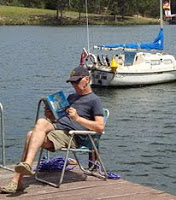The local Ovambo people call Namibia "the land God made in anger" and as the sun mercilessly bakes deserts, plains and mountains alike, it is a close cousin to hell. Namibia, or South West Africa as it was called then, stretches north from South Africa's Orange River along 1280 kilometres of the loneliest, yet in parts most hauntingly beautiful coastlines touched by the Atlantic Ocean.
I spent six months in Lüderitz, a very German town squeezed in between the desiccating sands of the Namib and the freezing waters of the South Atlantic’s Benguela current, where German is spoken as much as Afrikaans (with a bit of English by those who are neither Germans nor Afrikaaners). There is only one road in and out, as the town is surrounded by the vast "Sperrgebiet" a 'no-go' diamond-mining area controlled by Consolidated Diamond Mines, or CDM as it was generally known, who created their own town Oranjemund at the mouth of the Orange River for the ten thousand or so Ovambos (the black people of the area) and thousand whites employed there.
The houses painted in improbable pastel shades make Lüderitz look like a toy town at times. The air is tangibly clean, even on the foggiest of mornings. Locals say that Lüderitz can have all four seasons in a day, as the weather can change in hours from bright, hot and sunny, to strong winds, to dark, cold and foggy – and then back to sunshine again. This variation, together with a cold sea and the prevailing southwest wind, rule out Lüderitz as a beach destination, though brave souls still take brief dips. I did - ONLY ONCE in the whole six months I was there!
The "kantoor" in which I had to spend my entire day was straight out of Dickens: dusty, old-fashioned, and run by an Afrikaaner woman by the name of "Mevrou Russo" who "commandeered" two other Afrikaaner women who treated the blacks abominably. To keep up with what they were saying, I bought myself an "Afrikaans-Duitse en Duits-Afrikaanse Woordeboek" which, more than fifty years later, is still in my library, together with dictionaries of Arabic, Burmese, Farsi, French, Greek, Indonesian, Malay, Samoan, and Pidgin.
 All set to leave Lüderitz for Cape Town en route back to Australia
All set to leave Lüderitz for Cape Town en route back to Australia
Six months in Lüderitz seemed a long enough servitude, and so I squared the account with my employers which left me with just enough money for the flight down to Cape Town and my sea passage back to Australia, but every so often I still watch the South African movie "Dirkie" to remind myself of where I had once worked and lived and to try and brush up on my almost forgotten Afrikaans.
The director of the movie, Jamie Uys, became best known outside South Africa for making "The Gods Must Be Crazy", and while there's something of "The Gods Must Be Crazy" in "Dirkie", the plot parallels more closely the far more successful "Walkabout" set in the Australian desert.
Lucky for you, the movie was also dubbed into English under the title "Lost in the Desert" for your enjoyment (or maybe not!) - click here.






